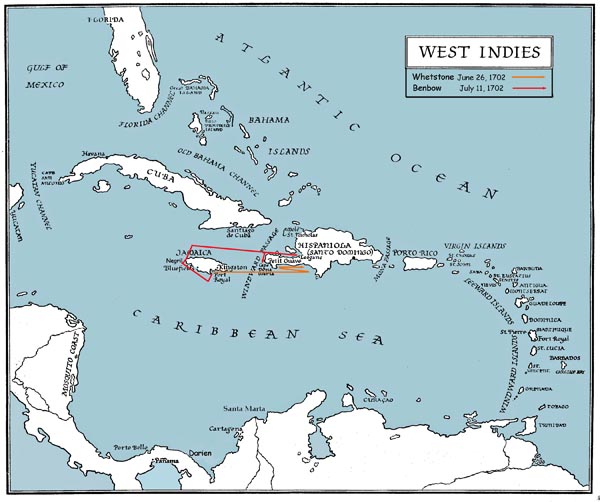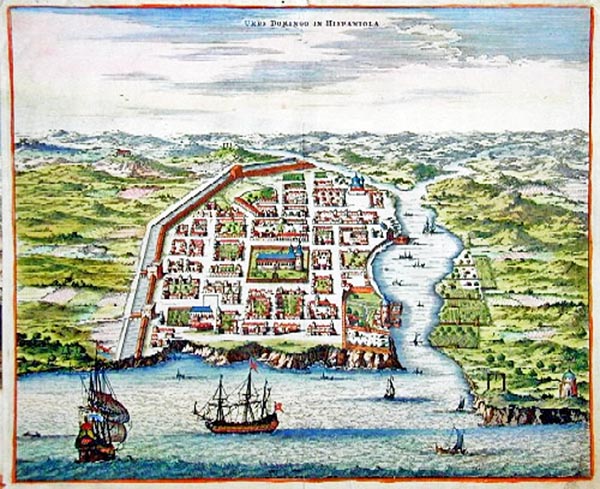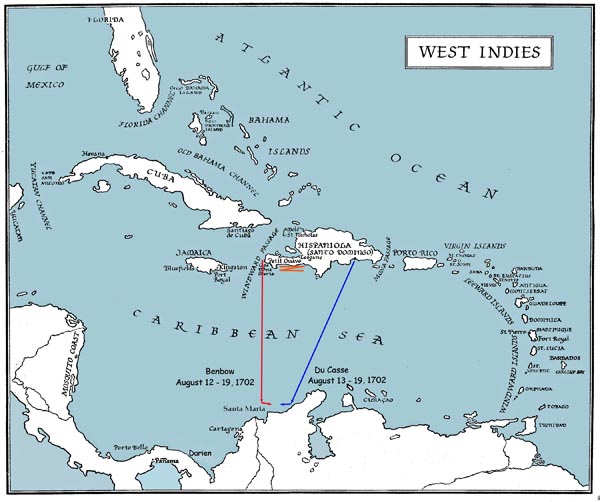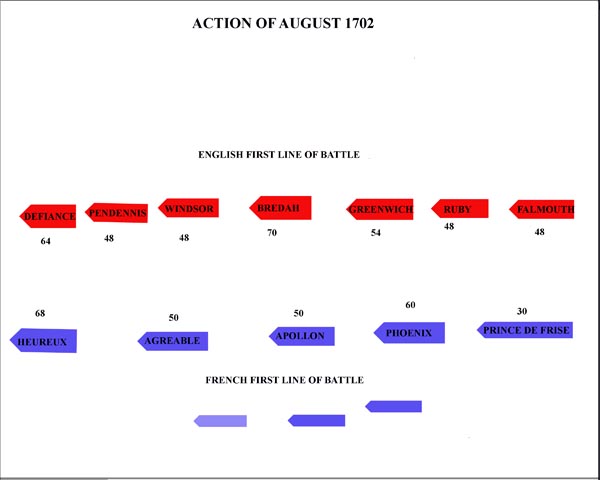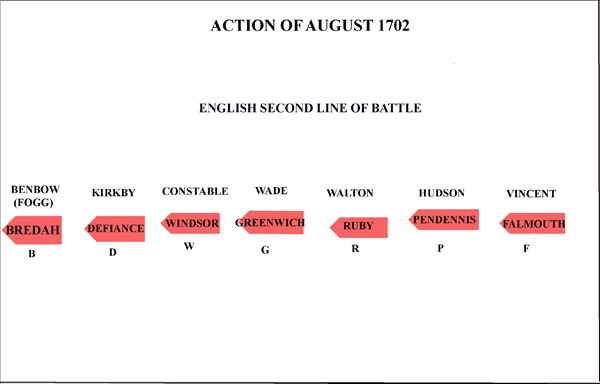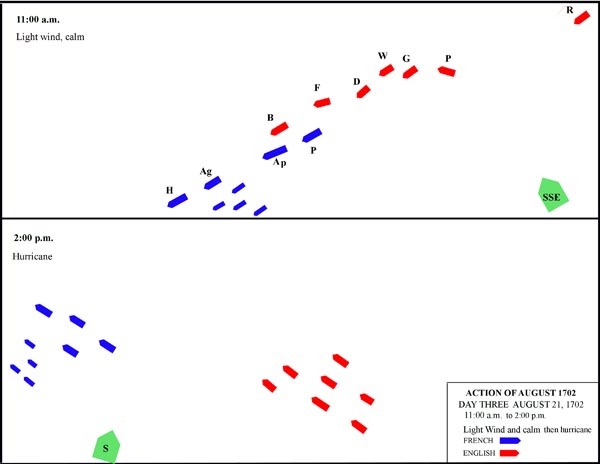Summer 1702
At the end of June, 1702, Benbow received intelligence that a small French squadron under the old buccaneer, Admiral Jean Du Casse, was expected at Port Louis, on the south western coast of French Hispaniola. Du Casse was conveying a new governor and troops to Cartagena on the Spanish Main.
West Indies
Benbow immediately dispatched Whetstone with his squadron to search for Du Casse on the south coast of Hispaniola.
Benbow took his squadron to the north coast of French Hispaniola to cover the capital Leogane. Here they destroyed a French man of war by driving it onto shore, burned two merchant ships and took several prizes.
Santo Domingo
On August 10th they learned that the French squadron had been spotted near Santa Domingo, the capital of the Spanish side of Hispaniola.
August 1702
Benbow turned southward for Santa Marta on the Spanish Main in hopes of intercepting Du Casse before he reached Cartagena.
Du Casse had heard of Benbow’s activities taking prizes around Leogane, and of Whetstone’s patrols around Port Louis. So he too made directly for Santa Marta, hoping to avoid direct confrontation with the English squadrons.
As the sun rose on August 19th the lookouts of the respective squadrons sighted each other. The two squadrons were converging, the English from the West, the French from the East, with an easterly wind.
First Line of Battle
The English squadron was composed of 7 ships of the line in the following battle order:
The Defiance (64 guns) Richard Kirkby
The Pendennis (48 guns) Thomas Hudson.
TheWindsor (60 guns) John Constable
The Bredah, (70 guns) Flag ship, Captain Christopher Fogg,
The Greenwich (54 guns) Cooper Wade .
The Ruby (48 guns) George Walton
The Falmouth (48 guns) Samuel Vincent
The French were made up of 4 ships of the line and one smaller Dutch built flute or frigate and three transports.
The Heureux (68 guns) Admiral Du Casse
The Agreable (50 guns)
The Apollon(50 guns)
The Phoenix (60 guns)
The Prince de Frise (30 guns)
The English outnumbered the French 7 ships of the line to 4; and outgunned them 392 guns to 258. The trap was sprung.
Day One: Wednesday August 19 – fleets converge
Benbow gave the signal for the chase. But what should have been a text book head on confrontation quickly deteriorated. The Pendennis and the Defiance were four miles to the rear. The rest had difficulty forming their line as they tacked north easterly against the wind. The French easily evaded Benbow by heading on a southwesterly course and were soon passing his disorganized ships. By 2 o’clock the French in full flight were 4 miles to leeward and Benbow’s line was just getting underway for the chase.
As the day waned the two lines had converged in line-ahead battle formation: in the rear the Falmouth had got up with the enemy’s sternmost ship, although the Greenwich and Pendennis were further astern or behind. And the Defiance was still far short of their van or head. At 4:30 the crash of cannon fire thundered across the waves. The Falmouth, not waiting for the Admiral’s order, fired its broadside on the Prince of Frise which was covering the troop ships to leeward or down wind. The Action had begun.
Day One: Wednesday August 19 – Action begins:
Du Casse in the Heureux, seeing the danger threatening his rear, immediately braced to and together with his second ship, the Agreable, fell upon the Defiance. The Windsor began to fire on the Phoenix, the third in line; and the forth, the Apollon, let loose her broadside at the Bredah.
Not thirty minutes had passed when the Defiance and Windsor ceased firing. The French van, the Agreable and the Heureux had slipped to leeward, just out of gun range while Kirkby kept the Defiance into the wind, rather than closing on the enemy. Constable dutifully followed his example. The Phoenix now fell back to aid the Apollon with which the Bredah was hotly engaged.
Engagement
To the rear the Falmouth and Ruby kept up their barrage against the Prince de Frise and Le Marin. The Greenwich and the Pendennis were astern of them with their shot not reaching. The Bredah persevered with the two French warships till darkness fell, around six.
English second line of battle
The Bredah suffered 15 men killed and several wounded in this exchange. The First Lieutenant of the Defiance was killed, which no doubt weighed heavily on Kirkby’s decision to luff out of the line.
Benbow decided to give the errant captains an opportunity to redeem themselves. He believed they lacked only a good example, which he would see the Bredah gave them. To accomplish this and check Kirkby’s lethargy a new line of battle was devised. This would have the Bredah leading, followed by the Defiance, Windsor, Greenwich, Ruby, Pendennis and Falmouth.
The pursuit continued through the night with very little wind. Only the Bredah and the Ruby kept up with the French. The others were three to five miles astern. Still the French fled.
Throughout the second day there were small winds and much calm. The ships barely made two knots. The Bredah and the Ruby fired their chase guns and Benbow again sent his boat to order Kirkby to make more sail. The Admiral even fired two canon shots at the Windsor to keep her in line. It was 10 at night before all of his ships had caught up.
Day three, Friday August 21, daybreak
The Third Day: Friday August 21, little wind.
Again at daybreak the Ruby and Bredah found themselves up with the French with the rest of their ships some miles astern. They exchanged heated broadsides for two hours with the Ruby suffering greatly.
The Defiance and the Windsor eventually got abreast the rearmost French ship, the Phoenix, but did not fire upon her. Benbow twice called to and signalled the Defiance to fire but to no avail, despite her boatswain acknowledging the signal.
Day three: 7:30 a.m.
At 7:30 a.m. Benbow broke off to tow the much shattered Ruby out of gunshot. He sent his second lieutenant with verbal orders to every commander to keep within one half a cable’s length of one another, upon their peril, the Ruby excepted.
Day three: 11:00 a.m.
At 11:00 a.m. Benbow re-engaged the two rearmost French ships. All of his ships, save the Greenwich, were within range of the enemy rear. They assisted as best they could but the Bredah, lying abreast of the enemy, received the brunt of the French fire, which galled her much in her rigging, sails, masts, and yards. The ships’ boats, towing out in front, were most vulnerable. The Falmouth had manoeuvred closer only to have her pinnace explode in a burst of wood, water, and men. Then the Bredah’s own long boat was hit and had to be cut away. The French managed to tow out of range.
Day three: Storm disrupts battle
About two a severe squall came out of the south, blowing hard with rain. The wind quickly increased to hurricane force. As they were driven WNW the sternmost of the French lost her fore topsail as it split asunder. The Defiance likewise had her foresail torn from its yard. At three the chase resumed and continued through the night.
Day four: drifting on different tacks
The Fourth Day: Saturday August 22. Little wind. Easterly, then shifted to the South West about 3:00 p.m.
The Bredah was one and one-half miles from the French; the rest of the squadron was spread out with the Greenwich and the disabled Ruby nine miles astern. The Defiance inexplicably shortened sail to slow its progress. At seeing this Captain Vincent of the Falmouth, broke the line and by-passed the laggard Defiance and Windsor, drew alongside Bredah, and requested permission to assist the Admiral, since nobody else would. Admiral Benbow enthusiastically accepted.
Day four engagement
About three thirty the Falmouth and the Bredah fetched within gunshot of the sternmost of the enemy, the Agreable and the Phoenix. The enemy ships exchanged strong fire as they drifted by on contrary tacks or directions, Most of the English ships managed a broadside or two with the distant enemy.
Day five: Sunday August 23
In the night Du Casse ordered the slow sailing Dutch ship to flee for Cartagena. He also resolved to have the flagship, the Heureux, his most powerful ship, take up the rear of his line since the English seemed intent on preying on his sternmost vessels. The injured Agreable led in the Van.
The Fifth Day, Sunday August 23, 1702. Wind from the East. Enemy in sight. Defiance and Windsor four miles astern. About 10 the Bredah engaged the Heureux at the rear of the French line. Agreable and Phoenix rallied to their admiral leaving a smaller ship unprotected. The Bredah and Falmouth took the Anne galley from the French.
The wind died in the afternoon, with the Defiance and the rest 3 to 4 miles astern. Benbow collected eight barrels of powder from each of his ships and ordered the Ruby to return to Port Royal with the Anne.
Despite a freshening gale in the evening which brought the line together, Kirkby’s detachment managed to fall back in the night.
Day five engagement
Day six: Monday August 24
The Sixth Day, Monday August 24, 1702. Little wind. The ships drifted in the currents. About 2:30 a.m. the wind shifted to NbW and in the starlight the Bredah and Falmouth came close to the Apollon. The rest of the English ships were four miles astern. After exchanging heated broadsides the Bredah grappled the Apollon.
Benbow personally led three separate attacks, suffering a large face wound and another to his arm.
At 3:00 a.m. the Admiral’s right leg was shattered to pieces by a chain-shot, and he was carried down to the orlop.
As soon as his leg was bound he ordered his cradle brought to the quarterdeck, and there, propped up, and in great pain, he resumed the direction of the battle.
This contemporary engraving shows Benbow courageously commanding his men to fight.
The two English ships kept up their onslaught upon the Apollon turning her into a wreck. Then about 5:00 a.m. the wind came easterly, allowing the other English ships to bear down to the battle. The Falmouth, herself badly disabled, towed out of range to the north to knot her rigging.
Then the unimaginable happened. The Defiance, which was headmost of the other English ships, instead of coming to windward between the enemy and the disabled ship, led the wayward division to leeward of the Frenchman. Kirkby ignored the signal for the line, put his helm aweather, wore ship, and bore away to the northwest before the wind.
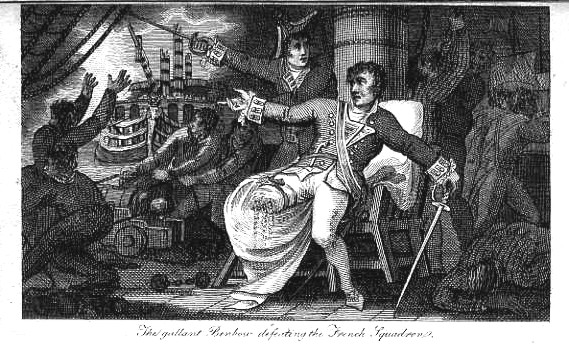
The Gallant Benbow defeating the French Squadron: Woodcut for “British Trident” published 1804, author Archibald Duncan
The Greenwich, Windsor, and Pendennis fired their upper guns as they ran past the Apollon on her leeward side and stood to the southward, neither following the Defiance nor coming in line with the Bredah. Benbow even fired two guns at his own ships to remind them of their duty, but to no avail.
The French, seeing the Bredah unsupported, bore down upon her. They gave her all the fire they had, raking her fore and aft above an hour. At seven of the clock that morning the Bredah finally and reluctantly edged away, giving up her prize.
These two engravings are from anthologies: the first titled “The gallant Benbow defeating the French Squadron” is from The British Trident, while the second, titled “Benbow continued to direct the fight” is from Outposts of Empire.

National Maritime Museum: coloured engraving; Artist: A.D. McCormick. (whereabouts unknown) Exhibited 1934: see Royal Academy Illustrated 1934
Mutiny
Captain Kirkby of the Defiance came on board the Bredah and urged Benbow to give up the chase. The other captains were summoned and all signed a paper that was drafted by Kirkby. In it he stated that they were undermanned and exhausted; they were short of ammunition; each ships masts, yards, sails, riggings, and guns were all in great measure disabled; the winds were so small and variable that the ships could not be governed; and finally they had seen how much stronger was the enemy in the six days battle.
Benbow answered each excuse and pointing out that only the Bredah had suffered in loss of men and damage: 60 men killed compared to no more than 8 in the rest of the squadron. He added that the wind was fresh and they had at that very moment the best opportunity to engage the enemy with their whole line abreast the enemy.
But the captains persisted. They only amended their paper to recommend that they not engage the French at this time, but keep company with them through the night, and if wind and weather improved, try their strength once again.
This finally convinced Benbow that they had no mind to fight, and were indeed cowards or had a design against him. He immediately put in writing his answer to the Captains’ paper, and then ordered his squadron back to Jamaica. There he imprisoned the captains pending courts martial.

